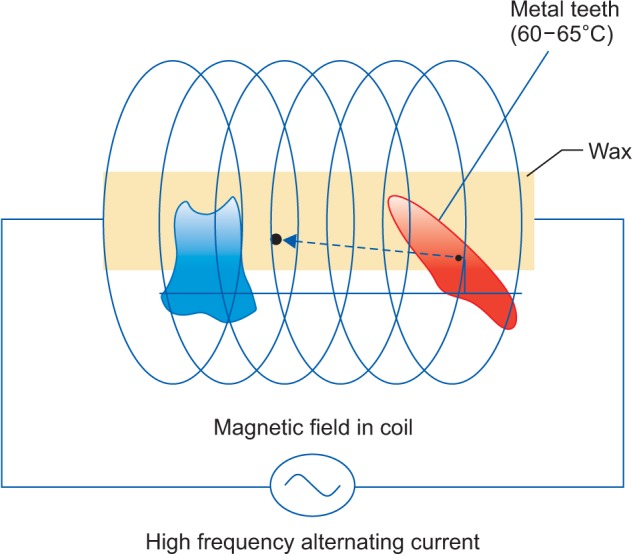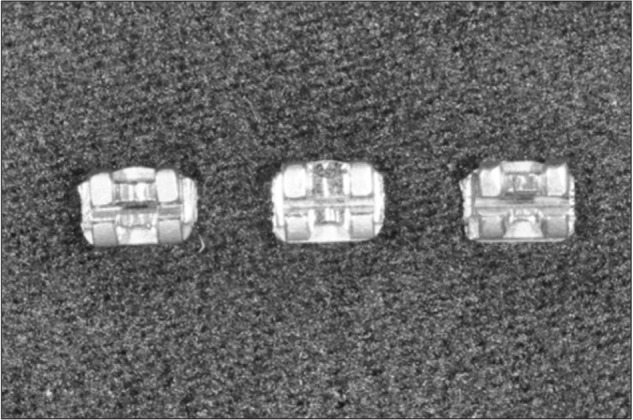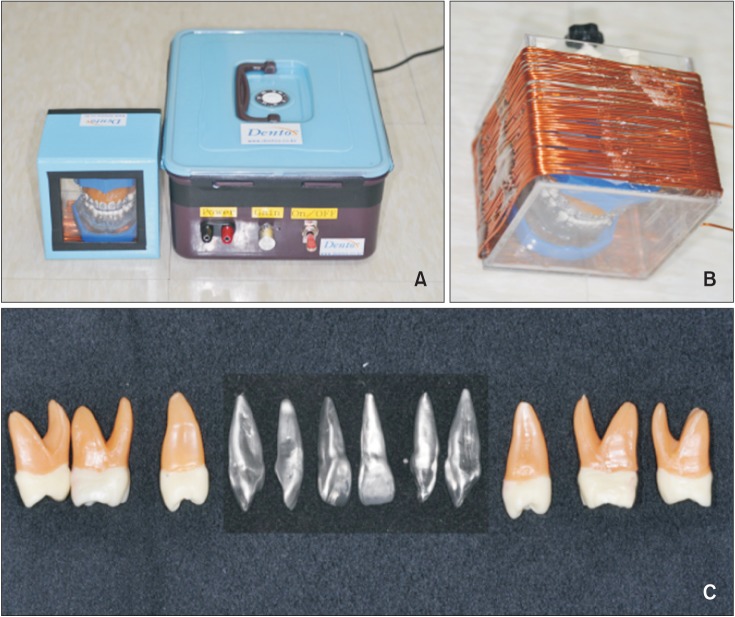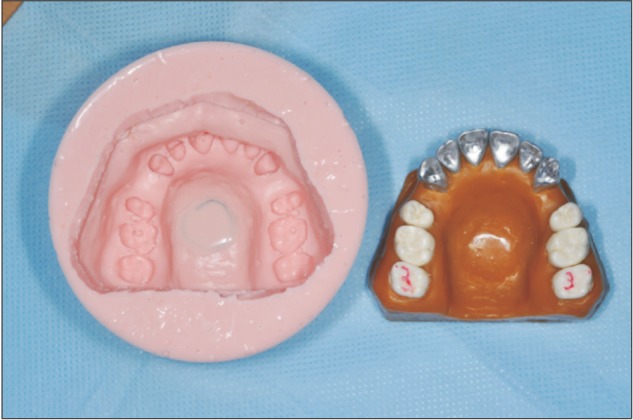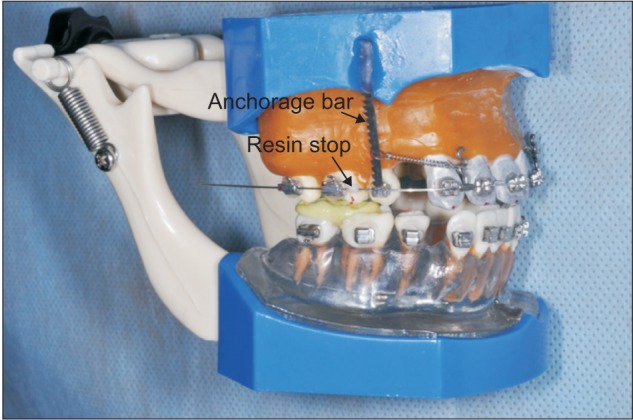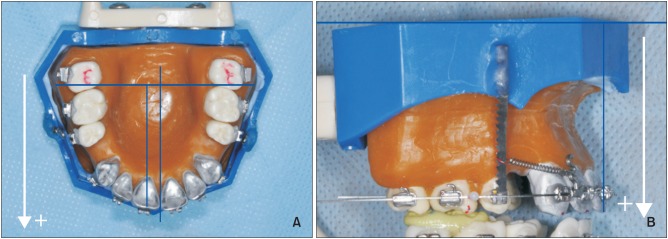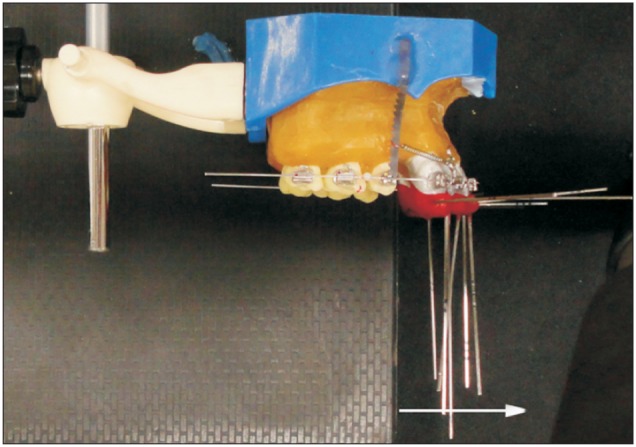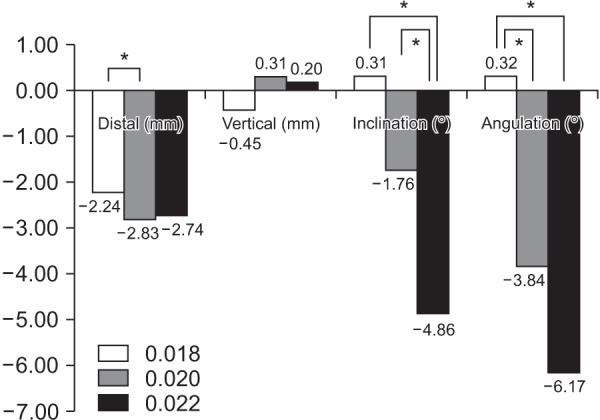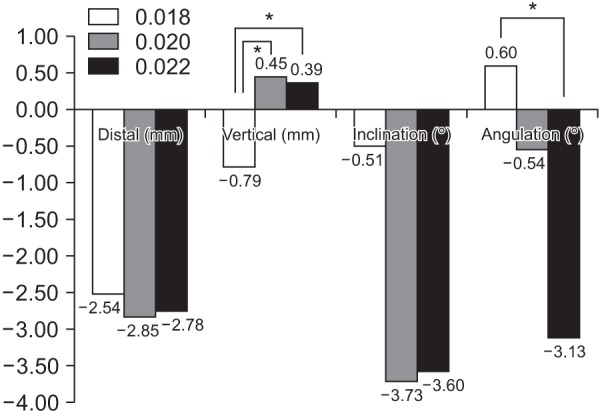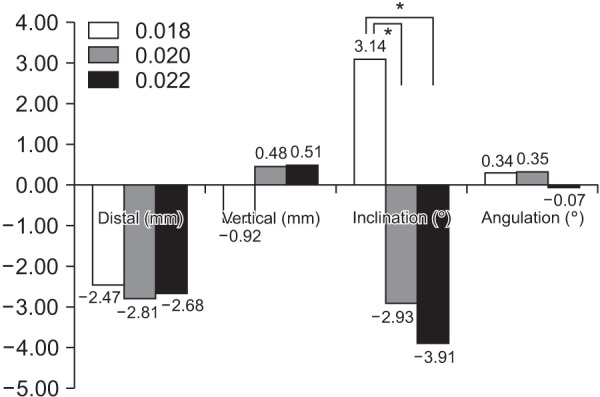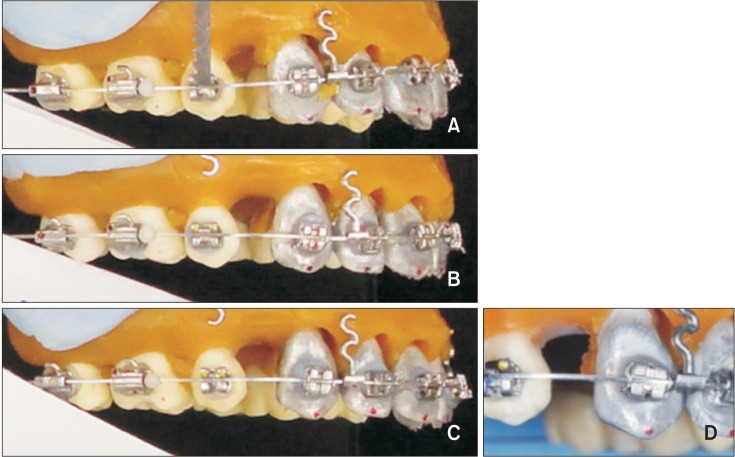Korean J Orthod.
2017 May;47(3):158-166. 10.4041/kjod.2017.47.3.158.
Effects of bracket slot size during en-masse retraction of the six maxillary anterior teeth using an induction-heating typodont simulation system
- Affiliations
-
- 1Department of Orthodontics, School of Dentistry, Kyungpook National University, Daegu, Korea. hmkyung@knu.ac.kr
- 2Department of Orthodontics, Faculty of Dental Science, Sri Ramachandra University, Chennai, India.
- KMID: 2379649
- DOI: http://doi.org/10.4041/kjod.2017.47.3.158
Abstract
OBJECTIVE
To investigate how bracket slot size affects the direction of maxillary anterior tooth movement when en-masse retraction is performed in sliding mechanics using an induction-heating typodont simulation system.
METHODS
An induction-heating typodont simulation system was designed based on the Calorific Machine system. The typodont included metal anterior and resin posterior teeth embedded in a sticky wax arch. Three bracket slot groups (0.018, 0.020, and 0.022 inch [in]) were tested. A retraction force of 250 g was applied in the posterior-superior direction.
RESULTS
In the anteroposterior direction, the cusp tip of the canine in the 0.020-in slot group moved more distally than in the 0.018-in slot group. In the vertical direction, all six anterior teeth were intruded in the 0.018-in slot group and extruded in the 0.020- and 0.022-in slot groups. The lateral incisor was significantly extruded in the 0.020- and 0.022-in slot groups. Significant differences in the crown linguoversion were found between the 0.018- and 0.020-in slot groups and 0.018- and 0.022-in slot groups for the central incisor and between the 0.018- and 0.022-in slot groups and 0.020- and 0.022-in slot groups for the canine. In the 0.018-in slot group, all anterior teeth showed crown mesial angulation. Significant differences were found between the 0.018- and 0.022-in slot groups for the lateral incisor and between the 0.018- and 0.020-in slot groups and 0.018- and 0.022-in slot groups for the canine.
CONCLUSIONS
Use of 0.018-in slot brackets was effective for preventing extrusion and crown linguoversion of anterior teeth in sliding mechanics.
MeSH Terms
Figure
Cited by 2 articles
-
Treatment of Class I crowding using simple tubes bonded with customized resin coverings: A case report
Seo-Rin Jeong, Hye-In Kim, Sung-Hoon Lim
Korean J Orthod. 2019;49(2):116-123. doi: 10.4041/kjod.2019.49.2.116.Comparison of inclination and vertical changes between single-wire and double-wire retraction techniques in lingual orthodontics
Bui Quang Hung, Mihee Hong, Wonjae Yu, Hee-Moon Kyung
Korean J Orthod. 2020;50(1):26-32. doi: 10.4041/kjod.2020.50.1.26.
Reference
-
1. Park HS, Bae SM, Kyung HM, Sung JH. Micro-implant anchorage for treatment of skeletal Class I bialveolar protrusion. J Clin Orthod. 2001; 35:417–422. PMID: 11494827.2. Jee JH, Ahn HW, Seo KW, Kim SH, Kook YA, Chung KR, et al. En-masse retraction with a preformed nickel-titanium and stainless steel archwire assembly and temporary skeletal anchorage devices without posterior bonding. Korean J Orthod. 2014; 44:236–245. PMID: 25309863.3. Lee J, Miyazawa K, Tabuchi M, Sato T, Kawaguchi M, Goto S. Effectiveness of en-masse retraction using midpalatal miniscrews and a modified transpalatal arch: Treatment duration and dentoskeletal changes. Korean J Orthod. 2014; 44:88–95. PMID: 24696825.4. Park HS, Kwon TG. Sliding mechanics with microscrew implant anchorage. Angle Orthod. 2004; 74:703–710. PMID: 15529508.5. Kim YC. Finite element analysis of the effect of wire thickness on tooth movement in sliding mechanics. MSD thesis. Daegu, Korea: Kyungpook National University;2003.6. Ji MJ. The effect of amount of torquing curve and thickness of archwire on the angulation of the teeth in six anterior teeth retraction. PhD thesis. Daegu, Korea: Kyungpook National University;2005.7. Song HS. Three-dimensional finite element analysis of tooth axis of maxillary anterior teeth during retraction with microimplant. MSD thesis. Daegu, Korea: Kyungpook National University;2006.8. Seo KW, Kwon SY, Kim KA, Park KH, Kim SH, Ahn HW, et al. Displacement pattern of the anterior segment using antero-posterior lingual retractor combined with a palatal plate. Korean J Orthod. 2015; 45:289–298. PMID: 26629475.
Article9. Lee HC, Chun YS. A photoelastic study on the initial stress distribution of 3 types TMA multi-vertical loop arch wire. Korean J Orthod. 1995; 25:73–85.10. Chaconas SJ, Caupto AA, Miyashita K. Force distribution comparisons of various retraction archwires. Angle Orthod. 1989; 59:25–30. PMID: 2923318.11. Caputo AA, Chaconas SJ, Hayashi RK. Photoelastic visualization of orthodontic forces during canine retraction. Am J Orthod. 1974; 65:250–259. PMID: 4521359.
Article12. Chen J, Isikbay SC, Brizendine EJ. Quantification of three-dimensional orthodontic force systems of T-loop archwires. Angle Orthod. 2010; 80:566–570. PMID: 20482364.
Article13. Kumar YM, Ravindran NS, Balasubramaniam MR. Holographic analysis of the initial canine displacement produced by four different retraction springs. Angle Orthod. 2009; 79:368–372. PMID: 19216610.
Article14. Moss ML, Skalak R, Patel H, Sen K, Moss-Salentijn L, Shinozuka M, et al. Finite element method modeling of craniofacial growth. Am J Orthod. 1985; 87:453–472. PMID: 3859222.
Article15. Chun YS, Row J, Jung SH, Kim HJ. A study on the effect of the magnitude of the gable bends on the tooth movement pattern during en-masse space closure in the maxillary dentition. Korean J Orthod. 2004; 34:33–45.16. Jeon HJ, Park SH, Jung SH, Chun YS. Three dimensional analysis of tooth movement using different sizes of NiTi wire on NiTi scissors-bite corrector. Korean J Orthod. 2009; 39:43–53.
Article17. Rhee JN, Chun YS, Row J. A comparison between friction and frictionless mechanics with a new typodont simulation system. Am J Orthod Dentofacial Orthop. 2001; 119:292–299. PMID: 11244423.
Article18. Kim SJ, Chun YS, Jung SH, Park SH. Three dimensional analysis of tooth movement using different types of maxillary molar distalization appliances. Korean J Orthod. 2008; 38:376–387.
Article19. Kyung HM, Kim JY, Kyung IK. Heat Induction Typodont System® (HITS) for simulating orthodontic tooth movement. Clin J Korean Assoc Orthod. 2013; 3:177–178.20. Park HS. Orthodontic treatment using micro. Seoul: Daehan Nare Publishing;2006.
- Full Text Links
- Actions
-
Cited
- CITED
-
- Close
- Share
- Similar articles
-
- Comparison of inclination and vertical changes between single-wire and double-wire retraction techniques in lingual orthodontics
- Force changes associated with differential activation of en-masse retraction and/or intrusion with clear aligners
- A comparison of en masse retraction of six anterior teeth with separate canine retraction
- Finite element analysis of the effects of different archwire forms and power arm positions on maxillary incisors in en masse retraction using fixed lingual orthodontic appliances
- Type of tooth movement during en masse retraction of the maxillary anterior teeth using labial versus lingual biocreative therapy in adults: A randomized clinical trial

